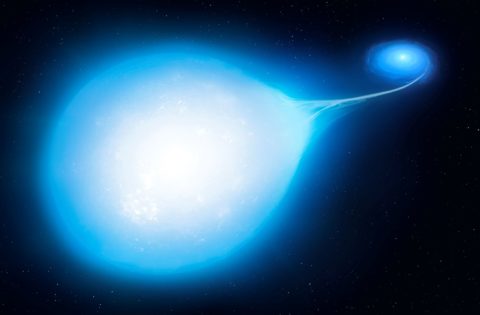Teardrop star en route to becoming a supernova

FAU astronomers investigate special star system before it explodes
Two stars orbiting around each other with increasing speed and ultimately shining as brightly as our entire galaxy: Supernovae are, in fact, nothing special, even if they can only be observed in the Milky Way every 400 years or so. Night by night, special telescopes make one or two such discoveries – after all, there are millions of galaxies in the Universe. What is special, however, is the discovery of stellar candidates in the heavens that will end up as supernovae relatively soon in astronomical terms, in around 70 million years. An international team of researchers led by the University of Warwick has succeeded in doing just that and astronomers at FAU have made an important contribution to this discovery. They recently published their findings in the journal Nature Astronomy.
The researchers came across the binary star system called ‘HD 265435’ because of unusual light variations of a teardrop star. This special shape is caused by a massive white dwarf in the proximity of the star distorting it with its intense gravity, which will also be the catalyst for a potential supernova – one of the very few star systems discovered to date in which the core of a white dwarf will one day reignite.
The binary star system is located around 1,500 light years away and consists of a hot subdwarf star and a white dwarf star. White dwarfs are ‘dead’ stars that have used up all their fuel and have collapsed in on themselves, making them small but extremely dense. The white dwarf in the binary star system discovered by the researchers has a similar mass to that of our Sun, but its diameter is only slightly smaller than Earth.
A type Ia supernova is thought to occur when the core of a white dwarf star reignites, causing a thermonuclear explosion. There are two scenarios where this can happen. In the first, the white dwarf gains enough mass to reach 1.4 times the mass of the Sun, which is known as the Chandrasekhar limit. HD 265434 fits into the second scenario, where the overall mass of a star system of multiple stars is near or exceeds this limit. To date, only a few other star systems have been discovered that reach this limit and will become type Ia supernovae.
The researchers were only able to observe the hot white subdwarf star as its partner, the white dwarf star, does not shine as brightly. Together with Prof. Dr. Ulrich Heber and Dr. Andreas Irrgang, David Schneider, doctoral candidate at the Dr. Karl Remeis Observatory Bamberg, Astronomical Institute of FAU, investigated the characteristics of the visible star and thus laid the foundation for further research on the binary star system. During their investigations, the astronomers evaluated the data from two telescopes, the W. M. Keck Observatory in Hawaii and the Hale Telescope at the Palomar Observatory in California, to confirm the temperature and density of the star. By using high-precision measurements from the ESA’s Gaia satellite, they also succeeded in determining its mass. The results indicated that the mass is sufficient for the subdwarf star to yield some of its mass to the white dwarf. As both stars are already orbiting around each other in only 100 minutes, they are close enough so that the white dwarf will inevitably go supernova in around 70 million years.Its companion will merge with it during this process. ‘That I had the chance to work on such an extraordinary discovery is something other doctoral candidates can only dream of. I am looking forward to finding out what else we can discover about binary star systems during the next few years or whether we can even find other supernova candidates,’ says David Schneider.
The researchers are particularly pleased about the fact that they can now investigate the binary star system in more detail in order to find out how supernovae occur and the precise physics behind it. This has mostly been a mystery until now. In addition, the supernovae of such star systems, or rather their comparably constant brightness and the specific change in brightness during the explosion, are used to measure the Universe as they serve as what are known as ‘standard candles’. To do so, astronomers compare the brightness with the luminosity observed on Earth and can use this to calculate the distance of the supernovae with a high degree of accuracy. By observing supernovae in distant galaxies, astronomers can combine their knowledge of the speed of this galaxy with our distance from the supernova and thus calculate the expansion of the Universe.
Lead author Dr. Ingrid Pelisoli from the University of Warwick explains: ‘The more we understand about how supernovae work, the better we can calibrate our standard candles. This is currently very important, as there is a discrepancy between the data we receive with this type of standard candle and the information we get from other methods. The more we know about how supernovae form, the better we will be able to understand whether this discrepancy is the cause of new physics that we’re not aware of, or simply because we are underestimating the inaccuracies in these distances.’
Further information:
Prof. Dr. Ulrich Heber
Phone: +49 951 95222 14
ulrich.heber@fau.de